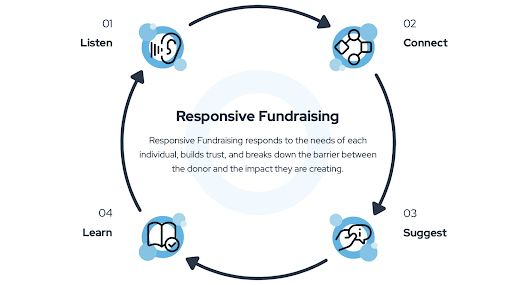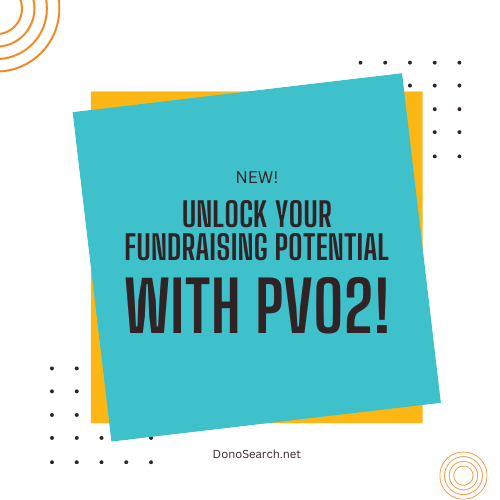4 Steps to Implement Responsive Fundraising with Donor Data
This guest post was contributed by Jenn Holcomb at Virtuous.
Philanthropic, wealth, and affinity data are incredibly powerful resources for fundraisers, but the right fundraising strategy is necessary to unlock the full potential of all of this information. Implementing the framework of responsive fundraising with wealth data is the ideal partnership for encouraging greater generosity with your supporters. Once you have the data you need, the right fundraising framework, and a responsive nonprofit CRM, you will be amazed at how your fundraising efforts grow.
What is Responsive Fundraising?
The responsive framework is a four-step cycle that fundraisers can use to create more powerful, long-lasting relationships with supporters of their organization. Through the steps of listen, connect, suggest, and learn — responsive nonprofits work to truly know their supporters and understand how they can best connect with them in meaningful ways.
With responsive fundraising, the focus of the organization shifts away from themselves and onto their supporters. Knowing, understanding, and respecting their supporters allows the organization to create a more personalized experience for supporters that ultimately leads to greater lifetime generosity. Understanding the four phases of the responsive framework will provide more context on how organizations can implement responsive fundraising with wealth data to create the biggest impact.

The 4 Phases of Responsive Fundraising: An Overview
1. Listen
Responsive fundraising relies on effectively listening to supporters by listening to them and the signals they give your organization. This listening will deepen relationships with supporters, resulting in increased donor loyalty, giving, and a community of advocates who are intimately connected to your cause.
2. Connect
Your engagement with supporters should reflect the personal nature of supporting your organization. Connecting with donors in a one-to-one, contextual, and collaborative way across different channels and mediums is essential for building strong relationships.
3. Suggest
After establishing trust with your donors through listening and personal connection, you can suggest the next best steps that fit each individual. Suggestions don’t always have to be financial and should align with a donor’s interests and capacity.
4. Learn
Experimenting and analyzing data from fundraising initiatives is the only way to know how well they are working for your nonprofit’s supporters. Continually learning and being responsive to donor feedback will lead to more effective fundraising strategies.
If you are interested in learning more about the framework of responsive fundraising, check out this free e-book from Virtuous: The Responsive Playbook.
The 4 Phases of Responsive Fundraising with Wealth and Philanthropic Data
Implementing responsive fundraising with wealth data is best accomplished by breaking it down into each of the phases. Responsive fundraising is a large umbrella philosophy that can (and should!) affect every part of your nonprofit’s fundraising strategy, but to simplify it is helpful to look at each phase and consider what role wealth data can play.
Phase 1: Listening
The first step in the responsive fundraising framework is listening. It involves paying attention to both direct and indirect donor signals. Wealth data is an indirect signal that can provide valuable insights into a donor’s capacity and interests. By understanding a supporter’s financial capacity, you have a better understanding of who they are and where they may fit in with your organization.
Additionally, while all donor data provides you with more context about the donor, historical philanthropic data in particular can give you insight into a donor’s interests by seeing their mission affinities. Seeing past giving from a donor lets you know what kind of things are important to them. That knowledge is key in helping you tailor your messaging to align with their passions.
How to use data to listen:
- Use wealth and philanthropic screening tools to gain insights into a donor’s capacity, affinity, philanthropy, and personal interests.
- Review past giving patterns to understand a donor’s giving history and preferences.
- Pay attention to how a donor interacts with your organization, including their engagement with your website, email campaigns, and social media to see if it aligns with what you learned from the data.
Phase 2: Connecting
The next step in the responsive fundraising framework is connecting. This step involves building a connection with your donors in a way that makes sense for them. Using the framework of responsive fundraising with donor data means that you have a rich historical context of your supporters’ philanthropic history, which is an ideal foundation for connection.
Based on the data you uncovered by listening, you can create messaging that will connect with your supporters in a personalized manner. Understanding their capacity to give and their philanthropic history along with the additional data you saw means you are set up to create a genuine connection with your supporters.
You’ll note that the emphasis at this phase is to connect. That means you are not yet discussing financial generosity, but rather starting to build a relationship. Understanding a donor’s capacity to give and previous philanthropic efforts gives you an incredible foundation to start these conversations based on the supporter’s past, but connecting with them is building a relationship for the future. A future that may or may not include financial support!
How to connect with your supporters:
- Personalize your outreach to donors based on their interests and past interactions with your organization. (Tip: to personalize at scale, consider a nonprofit CRM that has automated marketing and email tools!)
- Use philanthropic history and affinity data to determine the primary interests of your donors that you want to discuss to connect.
- Leverage storytelling to connect with donors emotionally and build a deeper connection.
Phase 3: Suggesting
The third step in the responsive fundraising framework is suggesting. This step involves making relevant suggestions to donors that align with their interests and capacity. At this point, wealth data becomes crucial to your relationship with your supporters. Responsive fundraising with wealth data enables your team to make the most appropriate suggestions to the right individuals.
How this works in practice is that by looking at a supporter’s capacity to give and philanthropic history, you have a much clearer picture of what the next step for them may be. If someone has a large capacity to give and clearly is interested in the mission of your organization, the next step is pretty straightforward. However, it often is not that clear. Here are some other scenarios you may encounter and ways you could approach making the suggestion:
- A supporter has a large capacity to give, but historically hasn’t shown interest in organizations like yours. In that case, lean into the connection you’ve made with that donor and start with a small financial ask or even invite them to a small event to get to know them better.
- Someone indicates a true passion for your mission but financially isn’t in a place to give. Suggest that they volunteer or become an advocate for your organization. They may be the perfect catalyst for financial generosity because their passion will inspire others.
Suggesting can be a challenge because you don’t want to leave opportunities on the table, but nurturing the relationships with your supporters is important. Responsive fundraising with wealth data gives you the framework and information you need to be thoughtful at this point in your donor relationships.
Ways to make a suggestion:
- Use wealth data to determine the appropriate level of giving for each donor.
- Make relevant suggestions based on a donor’s past giving history and affinities.
- Provide non-financial next steps for individuals who are not in a good place for a financial suggestion. Examples include volunteering, advocacy, sharing your mission on social media, attending an event, etc.
Phase 4: Learning
The final step in the responsive fundraising framework is learning. This step involves creating systems that are testable and analyzing the results to improve future fundraising efforts. Learning ensures that you are constantly improving your fundraising efforts and becoming more responsive over time. Even if one fundraising initiative worked well this year, it may not be as effective next year or the year after. Constantly testing, innovating, and learning prevents your fundraising from becoming stagnant.
Having the right tools is key to effectively implementing this step. Wealth, philanthropic history, and affinity data is the foundation for listening, connecting, and suggesting, but learning is all about the data around your fundraising initiatives. A responsive nonprofit CRM with data and analytics tools will make this step easier. Build learning into your regular team cadences. At the end of a campaign, evaluate the effectiveness of your campaign. Once a quarter, check to see how your automated, personalized communications are performing.
Learning must be a part of your organizational culture in order for it to be truly effective. Build in moments for reflection and change to grow generosity more and more over time.
Ways you can learn:
- Use analytics tools to track and measure the success of your fundraising campaigns.
- Use A/B testing to compare the effectiveness of different fundraising strategies.
- Continuously evaluate and adjust your fundraising strategy based on the results.
Key Takeaways
In conclusion, responsive fundraising is a holistic approach that involves listening to your supporters, connecting with them in a meaningful way, making relevant suggestions, and learning from the results. Wealth, philanthropic history, and affinity data all play a critical role in each of these steps, providing insights into a donor’s capacity and interests. To effectively implement responsive fundraising with wealth data, it is essential to have the right tools in place and build the framework into your team’s culture. By implementing the responsive fundraising framework and utilizing wealth data, nonprofit organizations can build stronger connections with their donors and inspire greater generosity from their supporters.
Want to learn more? Check out this free, on-demand webinar where experts from Virtuous, Overflow, and DonorSearch discuss how to strategically increase major gifts!

